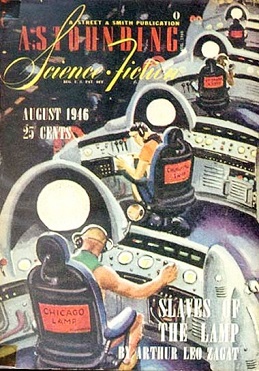
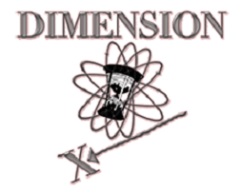 Dimension X (April 1950-September 1951) aired “The Last Objective” on June 3, 1951 as the 35th of its 50 episodes, though episode numbers vary depending on the source. Some have the total as 46 original episodes, with the rest being either rebroadcast from the original script or rescripted and then rebroadcast.
Dimension X (April 1950-September 1951) aired “The Last Objective” on June 3, 1951 as the 35th of its 50 episodes, though episode numbers vary depending on the source. Some have the total as 46 original episodes, with the rest being either rebroadcast from the original script or rescripted and then rebroadcast.
Paul A. Carter’s (September 3, 1926– ) novelette originally appeared in the August 1946 issue of Astounding Science Fiction (cover at right). Not prolific and with no novels to his name, Carter would publish 11 stories sporadically from 1946 through 1989, of which “The Last Objective” was his first. In 1989 he would collaborate with Gregory Benford on two stories, and his last appears to have been the short story “A Song for Herrmann” in the Winter 1994 issue of the now defunct Marion Zimmer Bradley’s Fantasy Magazine. While less remembered today for his fiction, Dr. Carter is more well known for his academic contributions to the field (he was a professor of history at Arizona State University), primarily through his two non-fiction critical works, The Creation of Tomorrow: Fifty Years of Magazine Science Fiction (1977) and Another Part of the Fifties (1983). He also served for decades as one of the jurors for the John W. Campbell Memorial Award for Best Science Fiction Novel, retiring from that position in 2009.
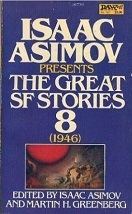 “The Last Objective” is a product of its time, one of many post-nuclear holocaust stories and novels to proliferate during the late 1940s and throughout the 1950s. Atomic war has devastated the surface of Earth and mankind has moved underground, with its military continuing the war against the enemy also under the planet’s surface, via tunnels. Carter gives us a dark, chilling psychological look at how this war might be fought, and what effects it might have on the combatants. He also adds an unforeseen (but legitimate) twist at the end, bringing an even more heart-breaking element to the tale, as it seems the madness of war has no end for some. The story was selected by Isaac Asimov & Martin H. Greenberg for Isaac Asimov Presents the Great SF Stories #8, 1946 (DAW pb, November 1982) and Asimov had this to say of it:
“The Last Objective” is a product of its time, one of many post-nuclear holocaust stories and novels to proliferate during the late 1940s and throughout the 1950s. Atomic war has devastated the surface of Earth and mankind has moved underground, with its military continuing the war against the enemy also under the planet’s surface, via tunnels. Carter gives us a dark, chilling psychological look at how this war might be fought, and what effects it might have on the combatants. He also adds an unforeseen (but legitimate) twist at the end, bringing an even more heart-breaking element to the tale, as it seems the madness of war has no end for some. The story was selected by Isaac Asimov & Martin H. Greenberg for Isaac Asimov Presents the Great SF Stories #8, 1946 (DAW pb, November 1982) and Asimov had this to say of it:
“After every great war there is an understandable revulsion against war in general–against the carnage, the destruction, the misery, and [to anyone with any brains at all] the stupidity. World War II was the greatest, bloodiest, cruelest war ever fought [at least to date] and its only saving grace was that it had an enemy worth fighting.
“Nevertheless, the coming of the nuclear bomb at the very end made it quite plain that World War III, if it ever comes, would finally achieve the crowning stupidity of war, the destruction of so much that no conceivable justification could exist for fighting. Here is a story that makes this quite plain in the military language that writers had learned from the war just concluded and yet a generation later, the world still prepares feverishly for a war only the insane would fight.”
To place the story in some sort of historical context (from the year it first saw print and not this 1951 radio adapation), science fiction in 1946 was a pretty fair year. Notable novels (first appearing in the magazines years earlier but now in book form for the first time) included A. E. Van Vogt’s Slan, E. E. “Doc” Smith’s The Skylark of Space, and The Time Stream by John Taine (pen name of Eric Temple Bell; 1883-1960). A pair of now classic SF collections also made library shelves in 1946: Adventures in Time and Space, edited by J. Francis McComas and Raymond Healy, and The Best of Science Fiction edited by the incomparable Groff Conklin. The magazines saw the first stories by Arthur C. Clarke, William Tenn, and Margaret St. Clair. On a sad note, SF pulpster and novelist Otis Adelbert Kline and the world-renowned H. G. Wells died. On a happier note, Alan Dean Foster, F. Paul Wilson, Robert Weinberg, Mark Geston, and Bruce McAllister were born. Oh, and the first bikini was designed and put on the market by Louis Heard, receiving much applause from men. It created almost as much of an explosion as did the atomic bomb tests on the island from which Heard took his skimpy swimsuit’s name.
The fourth worldcon (the first being in 1939; it was suspended for several years during the war) was helmed by Forrest J Ackerman in Los Angeles and nicknamed Pacificon. There were no Hugo awards in 1946; their time was yet to come.
Play Time: 23:45
{After listening to “The Last Objective” in June of 1951 the neighborhood space cadets could hardly wait to get to the corner drugstore for more SF stories in their favorite magazines, though hopefully of a more optimistic outlook. Astounding was a for-sure purchase, and 1951 saw it maintain its monthly schedule. The cover story was Eric Frank Russell’s now classic “…And Then There Were None.” It comprised the final third of Russell’s 1962 novel The Great Explosion, which would go on to win the Prometheus Hall of Fame Award in 1985. (The Prometheus Award is given by the Libertarian Futurist Society for the best libertarian SF of the year, and in 1985 both Russell and Poul Anderson were honored with Hall of Fame status, Anderson for his 1964 collection Trader to the Stars.) Two new magazines caught the eye of the gang, both debuting in October of 1950. Galaxy was monthly in 1951 and would remain so until 1958 when it would go bi-monthly from 1959-67. From 1968-78 its schedule was erratic, publishing from 6-12 issues a year. It took a nose-dive in 1979 with only three issues, and published its final and only 1980 issue in July. Imagination would publish from October 1950-October 1958. The first three issues were edited by Ray Palmer, the remainder by William Hamling. Not considered a top-tier SF magazine (Hamling emphasized entertainment and adventure in the magazine’s stories), it nevertheless enjoyed a 63-issue run and would publish the likes of heavyweights Philip K. Dick, John Wyndham, Robert Bloch, George O. Smith, Frank M. Robinson, and Robert A. Heinlein, not to mention Robert Sheckley’s first professional sale. The issue below was Imagination‘s fifth, and sported one of Hannes Bok’s beautiful covers.}
[Left: Astounding, June 1951 – Center: Galaxy, June 1951 – Right: Imagination, June 1951]
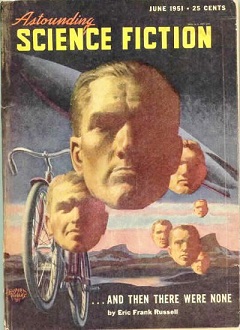
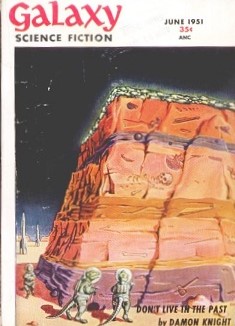
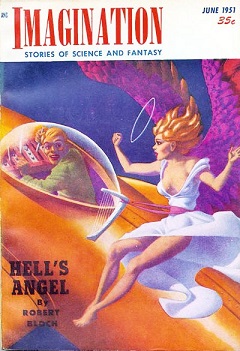
To view the entire list of weekly Old Time Radio episodes at Tangent Online, click here.